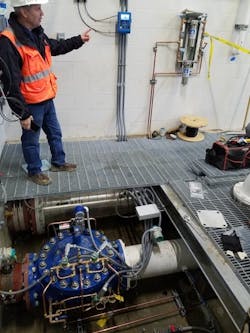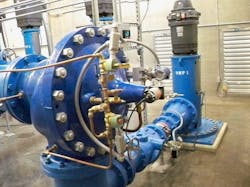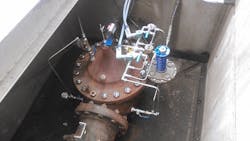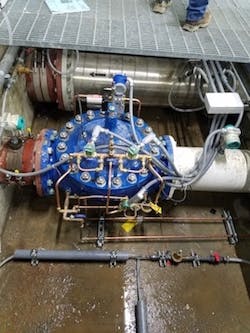About the author:
Roger Lah is a technical products specialist for Cla-Val. Lah can be reached at [email protected].
The process when a power failure occurs and what that means to a utility’s water treatment plant operator is an enormous task. The operator has to manually close 15 motorized valves to prevent water overflowing onto the plant floor. The valves usually are controlled by a programmable logic controller (PLC) to control flow into a filtration backwash process, utilizing venturi flowmeters. These types of valves are susceptible to cavitation problems, and a hydraulic pressure-reducing valve is normally installed upstream to reduce the pressure and prevent cavitation.
This arrangement requires significant piping space for two valves and a venturi flowmeter. Power failure to the motor-operated valve can cause problems.
Relieving Pressure
The hydraulic pressure-reducing valve can now be replaced with a hybrid multifunction electronic and hydraulic metering valve. The valve is capable of measuring and controlling flow based on valve position and differential pressure sensors installed on the valve. It incorporates anti-cavitation trim to prevent cavitation due to the high pressure drop into the filtration process.
The electronic metering function utilizes dual solenoids, and changing the upstream closing solenoid from normally closed to normally open will result in hydraulic valve closure when a power failure occurs. This allows the plant operator to handle other important duties when the inevitable loss of power happens. The single metering valve replaces the previous lengthy pipe arrangement. The replacement valve discharges directly into the filtration process, and a hydraulic pressure-limiting function can be added to provide a “hydraulic guarantee” against over-pressurizing the system.
In another treatment plant application, this time utilizing prefabricated treatment equipment, a hydraulic pressure-reducing valve is used to limit the pressure into the process. A relief valve provides protection for a 10-mile pipeline feeding into the plant, when a fast-closing butterfly valve shuts down the process.
The engineer’s surge analysis determined the pressure reducing valve was required to close in 12 minutes when this occurs and a standard closing needle valve is incapable of controlling the long closing times. The answer was to modify the pilot control system to perform a switch between the normal pressure reducing function and electronic controlled closing of metering flow to zero flow, in a programmable time period.
A third solenoid switches between the normal hydraulic control to electronic control when the system shuts down. Operators can see on the valve controller screen the status of the closing sequence. They also are able to adjust closing times, if the required closing time requires amendment.
The valve accomplishes two important functions: a hydraulic pressure-reducing function during normal operation, and an electronic “time of closure” function to prevent surging in the long upstream pipeline.
Combining Electronic & Hydraulic Functions
Many hydraulic and electronic functions can be combined into one valve, which can reduce the number of valves in an installation, protect aging and sensitive pipes, or prevent overflow of tanks and reservoirs. An electronic flow control valve with a hydraulic pilot control to limit downstream pressure are a popular combination. This example of hybrid electronic and hydraulic control allows normal electronic flow control unless downstream pressure exceeds the limit of the hydraulic pilot set point.
Electronic Flow & Hydraulic Protection
At one recent project startup, when an electronic flow control valve began to open, it would barely crack open. A check of the downstream pressure gauge revealed that downstream pressure had reached the setting of the pressure-limiting pilot control. It transpired that the water district had forgotten an isolation valve had been closed some distance downstream. In effect, the hydraulic control system prevented a pipe break from occurring.
The electronic control system is capable of multiple functions, such as flow control and pressure reducing. In this instance, the hydraulic pilot can be used as “backup insurance” where the pilot control adjustment is set to not interfere with normal electronic multifunction control. Normal operation consists of electronic flow control and electronic pressure-reducing control and seamlessly transfers between functions with specialized software. In the event of power failure, the hydraulic pilot will take over and limit downstream pressure, preventing pipe breakage.
Up to four modulating electronic functions are possible, including flow, pressure sustaining, pressure reducing and level control. Reservoir level control, for example, can include flow control and pressure-sustaining control. Conversions of existing altitude control valves often include the hydraulic altitude control pilot for backup control to prevent overflowing of a tank. Often there is a long pipeline upstream of these valves that is susceptible to surging during valve closure. A hydraulic “surge relief override” pilot control prevents this in case of faster than normal valve closure.
Hybrid Electronic Multifunction Valve Conversion
Motorized valves typically are used to control a single function and offer limited or no capabilities to provide multiple electronic functions with hydraulic backup functions. Replacing these valves with hybrid electronic and hydraulic control can certainly reduce the number of valves required and can offer very useful “insurance” against power failures and costly line breaks.



